I love citrus fruit, but living in the Vermont mountains, I don’t often have access to freshly grown lemons, limes, or oranges.
Fortunately, while perhaps not quite as impressive or fruitful as a tropical citrus orchard would be, it is possible to successfully grow citrus plants in pots indoors. Even here, in my USDA Hardiness Zone 4 climate, where snow coats the ground for practically half the year.
While growing citrus indoors can be a bit tricky, with just a few pointers, you can easily fill your windowsill with enough lemons to make lemonade!

We link to vendors to help you find relevant products. If you buy from one of our links, we may earn a commission.
Here’s what’s to come in this article:
What You’ll Learn
Let’s get to growing, shall we?
Getting Started With Citrus as Houseplants
First, you need to find an adequate pot. You will need a large pot with sufficient drainage holes.

You may want to consider starting the plant in a smaller pot, and moving up to a larger size as it grows so that the ratio of plant to potting mix isn’t too broad.
If there’s significantly more potting material than there are roots, the soil may remain overly moist after watering, increasing the chance of root rot.
To start out, look for a pot that is at least 8 inches wide and 10-12 inches deep. A 5-gallon pot is ideal.
As the tree matures, move it up to a container that is 18-24 inches deep.

Larger pots will prevent top-heavy trees from tipping over, while also allowing plants to grow larger roots and be more productive. Keep in mind, however, that the larger the pot is, the heavier the plant will be to move.
This could pose a problem when it comes time to move it outside with the return of warm weather, or from room to room.
Find a pot you like. Terra cotta, unglazed ceramic, plastic, fiberglass, wood, or resin containers are all fine choices. Just don’t use the black plastic pot that your plant comes in from the nursery, as this material will absorb and retain heat from the sun, and can cook the roots.
Whatever pot you choose, give preference to a lighter color, and be sure to place a deep saucer underneath to prevent moisture from seeping onto your floor. A plant stand or cart with wheels can also make a nice addition, for ease of movement.
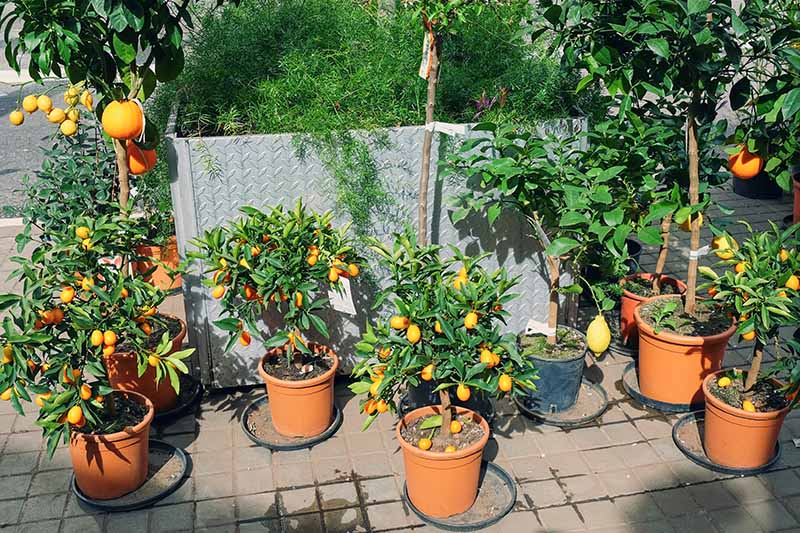
Citrus plants also need well-draining soil.
Fill the pot with a citrus soil blend, or use regular potting soil mixed with perlite, small gravel, pumice, or expanded shale, which will help to ensure adequate drainage. Use two-thirds potting soil to one-third inorganic material.
Or you can make your own using equal parts peat, sand, perlite, and bark.
Don’t plant in soil devoid of inorganic material or use a commercial mix that is designed specifically to retain moisture, or it will end up getting waterlogged.
Planting Citrus Trees Indoors
For indoor growing, you want to choose a dwarf variety, as standard citrus trees will be much too large to contain in most indoor spaces, unless you have a high-ceilinged atrium available.
These dwarfs will be sold grafted onto roots which limit their growth size, and increase the speed of fruiting.

When transplanting into your chosen container, look for the graft union. This will look like a scar or bump where the fruiting stock has been grafted onto the rootstock. You’ll usually find it about 4-8 inches above the root ball.
Plant the root ball into the soil, making sure that the graft is at least 2 inches above the soil line.
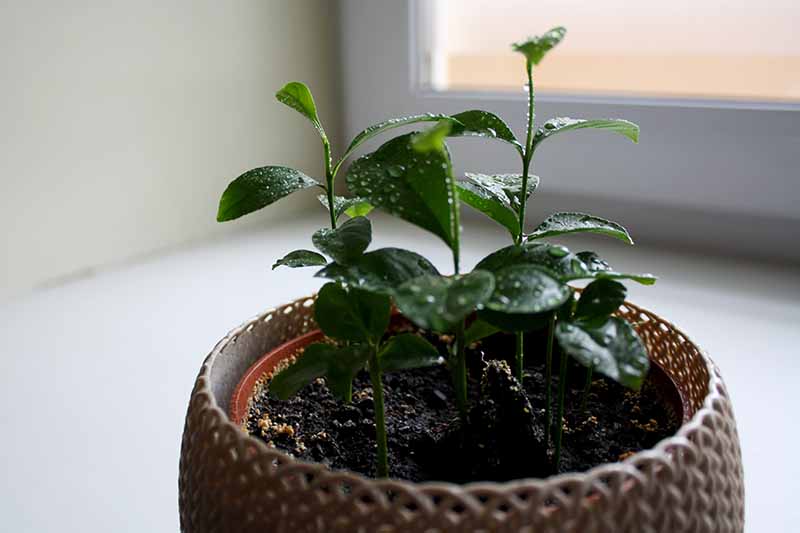
If any young green shoots are present below this graft area, prune them off, as they will use up valuable nutrients to grow but will not produce fruit.
Indoor Citrus Growth and Care
Citrus trees are tropical plants that require lots of light, warmth, and adequate moisture in order to thrive and produce fruit.
Though it varies by variety, citrus trees tend to bloom in spring, with fruit developing over the summer, and ripening slowly into the fall and through the winter.
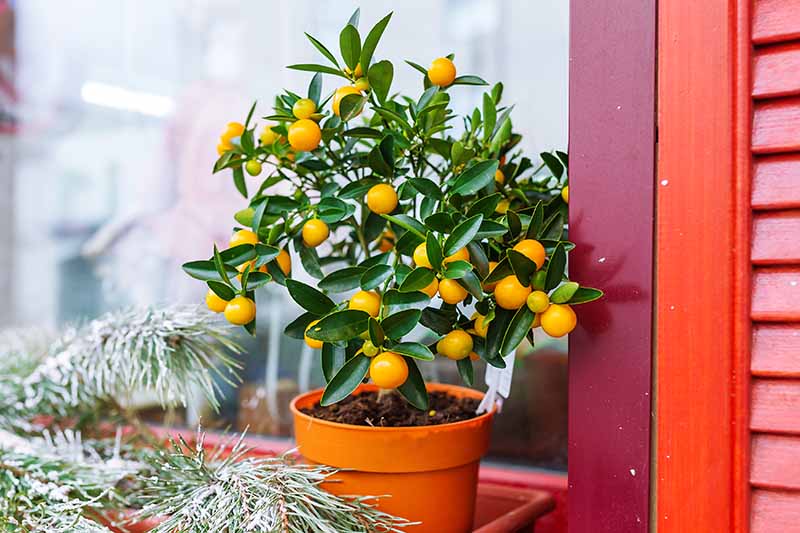
Growth does slow a bit during the winter, though trees will not go completely dormant when grown indoors. Therefore, they will need sufficient light and water year round.
Although they are self-fertile, when grown outdoors, citrus trees will be pollinated by insects or wind. It’s a good idea to hand pollinate your plants.
To do this, just take a Q-tip or small paint brush and move from flower to flower, brushing the center of each one.
Light
Look for a place in your house where the plant will get as much bright light as possible, such as a south or southwest facing window.

If your plants do not get at least 6 hours of direct light a day, which they likely won’t in more northern climates, you will need to provide a supplemental light source.
Though they can still survive in lower light conditions, they will be unlikely to flower or produce fruit.
Choose a tall LED grow light, which will give off a little warmth and replicate sunshine. Make sure not to place the light too close to the plant or it may burn the foliage.
Position your grow light about 18 inches above the canopy for best results.
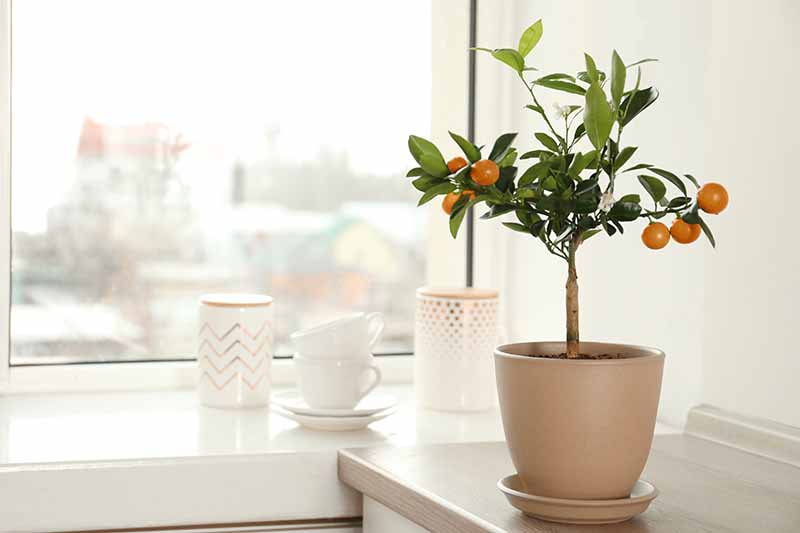
During the winter, keep the lights on for about eight hours a day. You don’t want to overdo it, or plants may become stressed and their ability to set fruit will be compromised. The idea is to mimic the amount of natural light plants normally receive during the season.
Temperature
Citrus is best grown in air temperatures between 55 and 80°F. Keep in mind that ideal temperatures vary between species.
Some cold-hardy varieties can tolerate temperatures approaching freezing for very short periods.
In order to flower, citrus requires 5 to 10 degrees of difference between day and nighttime temperatures, so turn your thermostat down a few degrees before bed.
When the weather warms up, you can move plants outdoors during the growing season to give them access to natural light.
Bring them outside once the air temperatures are consistently above 50°F, transitioning them to their new conditions over a period of a couple of weeks.
Gradually move them from a partly shaded spot to one with full sun, eventually setting them in the sunniest spot you can find. Provide protection from wind, and keep the pots in their saucers to maintain good drainage.
Never place them in areas with standing water.
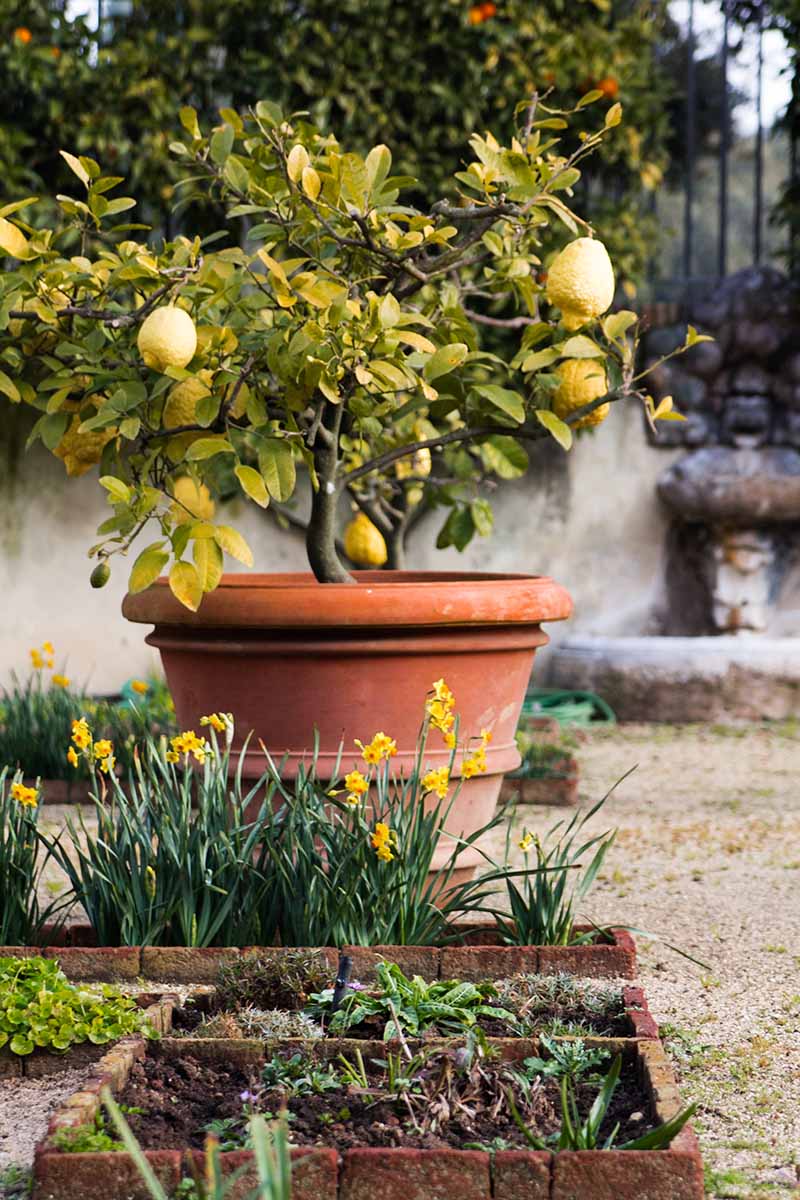
Find a warmer microclimate in your yard, such as near a building where there might be some heat reflected from a walkway, driveway, or porch.
It is especially important to avoid any abrupt changes in light exposure or temperature. If you transition them too quickly, leaves could become sunburned and flowers and fruit may drop.
Move trees back indoors before nighttime temperatures drop into the 40s.
Water
Another key to successfully growing citrus in pots is appropriate watering. It is important that the soil should remain moist, without ever becoming waterlogged.
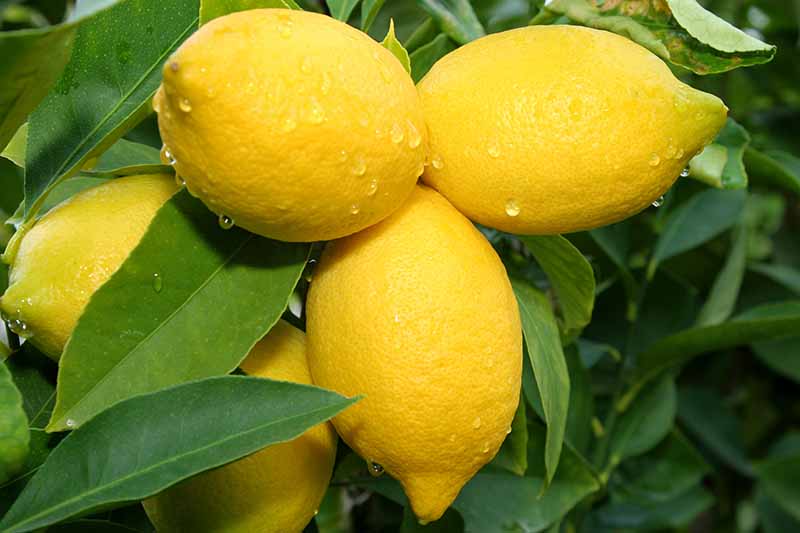
The exact amount of water required depends on a number of variables, including the size of the container, type of potting mix, air temperature, and humidity.
The most important thing is to water regularly to keep the soil moist, but never to let it become overly saturated.
It is better to do infrequent deep waterings rather than frequent shallow waterings. Let the soil dry to a couple of inches deep, and then water thoroughly until water seeps out of the drainage holes in the bottom of your pot.
During the spring and summer when growth picks up, trees may need daily watering. In the winter when plant growth slows, water only enough to maintain soil moisture.
Look for yellowing or curled leaves, which could be a sign of over watering.
Fertilizer
Citrus plants are heavy feeders. They need liberal quantities of nitrogen as well as essential trace minerals including iron, magnesium, manganese, and zinc for adequate growth.
Excessive nitrogen can cause the plant to put more energy into leaf growth, and impede flowering and fruiting.
Citrus trees typically store nitrogen in their roots and wood, and utilize these resources during flowering and fruiting periods rather than taking up nitrogen from the soil. It’s best to apply fertilizer before the tree has begun to flower, and again after it has finished fruiting.
Since regular watering can leach nutrients, it is important to provide a source of fertilizer for indoor plants.
Choose a product labeled for use on citrus plants, such as the one pictured above.
You can purchase citrus-specific fertilizers from Nature Hills Nursery.
The most important thing is to be sure to use a complete fertilizer that contains nitrogen, phosphorus, and potassium (NPK). You may also need to supplement with trace minerals including iron, magnesium, and zinc, though these are often included in multipurpose fertilizer mixes.
A granular slow release fertilizer will provide best results. Supplementing with a liquid feed is recommended if you notice yellowing foliage, which can be a sign of nitrogen deficiency.
FertiLome Fish Emulsion Fertilizer
Try this 5-1-1 fish-based fertilizer, available at Nature Hills.
Apply fertilizer just as new growth is beginning to appear in the late winter or early spring, and continue through the summer until growth slows down in fall.
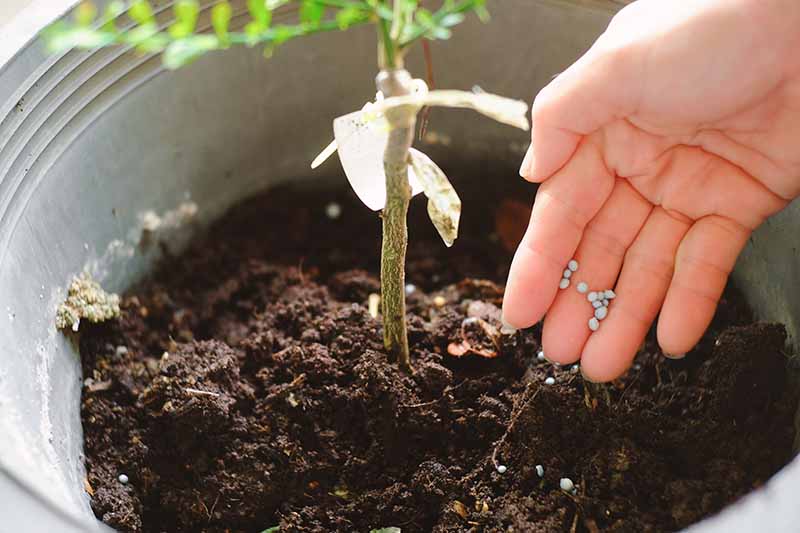
Follow instructions on the product packaging for recommended application amounts and frequencies. Always use a fertilizer designed specifically for citrus.
Pruning
While pruning is not necessary for healthy growth and fruit production, it is useful to keep indoor trees compact and mobile.
Trees can be pruned at any time during the year except when blooming and developing fruit, as this diverts energy away from fruit production and into new foliar growth.

Start by taking note of the general shape of the tree, looking for areas that are off balance or branches that are damaged or broken.
Use clean, sharp pruners to make cuts, always with the blade pointing towards the tree to reduce potential damage.
You can regularly trim growing tips to maintain your preferred shape and size. For a neat and compact shape, look for new shoots and shorten them back to about half of their length, cutting just above a leaf.
You can also remove dead wood and thin out inside branches to let light penetrate to the center, and promote good air circulation.
Growing Tips
- Provide at least 6 hours of direct light a day, supplementing with an LED grow light if necessary.
- Keep indoor temperatures between 55 and 80°F, and lower the thermostat a few degrees at night.
- Move plants outdoors in the spring once low temperatures are above 50°F, and indoors when nighttime temperatures drop into the 40s.
- Avoid any abrupt changes in light exposure or temperature.
- Water regularly, keeping soil moist but never waterlogged. Infrequent, deep waterings are best.
- Feed regularly with a granular fertilizer to ensure a sufficient supply nutrients.
- Prune foliage after fruiting, to maintain desired shape and provide balance to the tree.
Choosing Indoor Citrus Cultivars
If you have access to dwarf root stock and established citrus trees, it is possible to to propagate them yourself from stem cuttings taken during the spring or summer. Cuttings will need to be grafted to the root stock in order to be successful.
Most likely, northern growers will need to purchase potted plants from local nurseries.

Purchased cultivars will generally be grafted as well, meaning that the rootstock is different from the variety that is fused to the top, which will become the productive plant.
Look for dwarf cultivars for container growing, as non-grafted trees will typically be much too large to grow indoors. The size of the fruit will not be affected by grafting, and dwarf varieties still produce full-sized fruit.
There are many wonderful options available for growing citrus indoors.
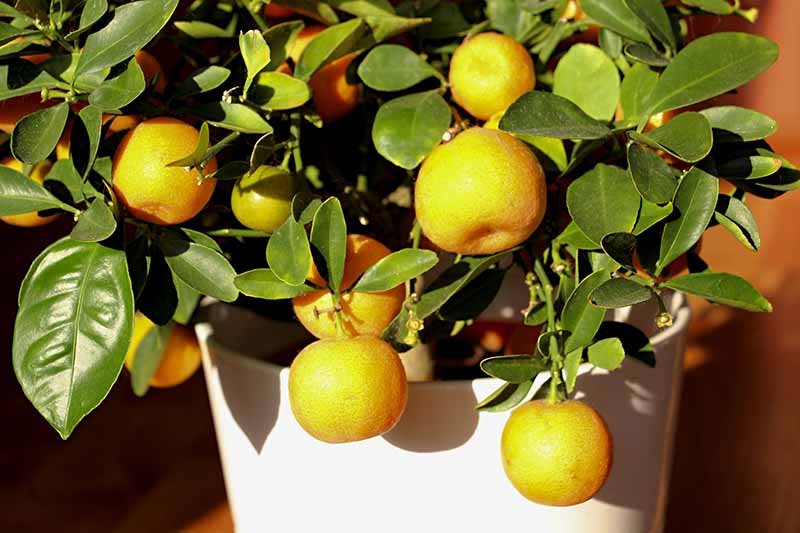
Citrus fruits with high levels of citric acid, such as lemons and limes, ripen faster than sweeter citrus varieties, making them a great choice to grow indoors in cool climates.
Less acidic citrus types such as sweet oranges tend to require more heat for fruit to ripen. While all types of citrus can be grown indoors, these heat-loving varieties may require more attention in order to achieve good yields.
Here are a few of our favorite cultivars for growing in containers:
Dwarf Meyer Lemon (Citrus meyeri)
This classic dwarf lemon is easy to grow indoors. It is a self-pollinating cross between a lemon and a mandarin orange.
It can flower and produce fruit throughout the year, increasing the likelihood that it will provide you with homegrown lemons that you can use in cooking or to make fresh squeezed lemonade. It can also remain outside in temperatures over 40°F.
One-gallon container Meyer lemons are available from Perfect Plants.
Of course, starting with a bigger tree means you’ll be that much closer to a fruitful harvest, right from the beginning. Improved dwarf Meyer lemons (C. x ‘Meyer Lemon Improved’) are adapted to a wide range of growing conditions, and this cultivar is disease resistant.
This is one of the more dependably productive fruit trees for growing in containers.
More mature 1- to 2-foot trees are available from Nature Hills Nursery. You can expect them to start producing fruit in about three years or less.
Bearss Semi-Dwarf Lime (C. latifolia)
Also known as Persian lime, this common grocery store variety produces large quantities of juicy, seedless fruit. The green skins will turn yellow if left on the plant to fully ripen. This is the most cold hardy of limes.
You can purchase plants in one-gallon pots from Burpee.
Calamondin Orange (Citrofortunella microcarpa)
A cross between a kumquat and a mandarin orange, this tree will provide an abundance of flowers and fruit, beginning in the second year of growth.

These bright orange fruits are very tart, and they’re wonderful for cooking.
Cold hardy, productive, and beautiful, this plant also grows well in containers.
You can order trees in gallon-sized containers from Via Citrus via Amazon.
Rio Red Grapefruit (Citrus Paradisi)
This heavy-yielding plant produces large pink grapefruit with an incredibly sweet flavor.
These naturally dwarf-size trees are perfect for growing in containers, and can be easily transferred back and forth between a porch and indoors.
You can purchase trees in 1 to 2-foot containers from Nature Hills.
Dancy Tangerine (C. reticulata)
This beautiful fruit-bearing dwarf has striking dark green foliage, abundant orange fruit, and fragrant flowers that will fill your house with a citrusy sweet fragrance.
A popular option for container growing, this cultivar produces an abundance of juicy, delicious fruit that is easy to peel – ideal for fresh eating or juicing.
Plants in various container sizes are available from Nature Hills.
Indio Mandarinquat (C. citrofortunella)
Why not try something unique with the ‘Indio Mandarinquat.’
This bell-shaped cross between a kumquat and a mandarin orange tastes like an orange, but with a bit of a sour kick. It can be eaten whole, complete with the peel. The fruit is wonderful in marmalade, syrup, or juice. Try it in a cocktail!
Wonderfully fragrant, this tree will be sure to cheer up your whole house. You can order three-year-old trees from Nature Hills.
For even more of our favorite varieties perfect for growing in containers, check out our roundup (coming soon!).
Managing Pests and Disease
Container plants are prone to similar pests and diseases as citrus grown in the garden, especially if they spend part of the year outside.
Pests
Contrary to what you might expect, pests can become especially troublesome with indoor growing. Since there are not many natural predators indoors to keep pests in check, populations can grow rapidly and cause significant damage.
Here are a few of the common ones that you may encounter:
Aphids
Trees can be susceptible to black citrus, cotton, and spirea aphids.
These pesky little insects can range in color from green to yellow or black. They feed on the buds and undersides of leaves, causing foliage to curl. Aphids also produce a sticky secretion called honeydew, which can cause a buildup of sooty mold on foliage.
Mealybugs
These flat, oval-shaped insects are pink with a white wax coat. They lay their eggs on the fruit, leaves, and twigs of citrus trees. As a result, they make the tree less vigorous. And they also produce honeydew, which can lead to sooty mold.
Get more tips on combating mealybugs here.
Whiteflies
The larvae of these small, white, winged insects feed on the undersides of leaves, causing foliage to turn yellow and drop. Like aphids and mealybugs, whitefly larvae also excrete honeydew that can cause sooty mold.
Read more about whitefly control in our guide.
Mites
These tiny pests are a common problem for indoor plants. They cause yellowing and dropping of foliage, as well as discoloration and shriveling of fruits.
If you are able to move plants into the bathtub or onto the porch, a strong spray of water can often be enough to remove pests, including any honeydew and accompanying mold. Make sure to spray the undersides of leaves.
You can also make a homemade insecticidal soap by filling a spray bottle with water, a couple of teaspoons of mild biodegradable soap, and a teaspoon or two of vegetable oil. Spray the foliage every few days, as long as the infestation persists.
A spray of cayenne or jalapeno pepper and garlic mixed with water can also deter pests. A word of warning, however: this may make your house smell a bit strong for a while! Be sure to wear gloves when working with hot peppers and protect your eyes when you apply the spray.
To prevent insects from getting out of control, keep citrus away from other houseplants, vents, doors, and window screens, and always give them a thorough rinse before moving plants indoors for the winter.
Diseases
When growing citrus in containers indoors, the trees aren’t as prone to disease as they are outdoors, but there are a couple of things to be aware of:
Sooty Mold
Sooty mold is a fungus that can impact indoor citrus trees.
Caused by infestations of sap-sucking insects, sooty mold is characterized by a black powdery coating on leaves and twigs.

The good news is, it is usually not a huge problem in terms of plant health, though it is not the prettiest. In severe cases, it can block light, stunt growth, and cause yellowing of foliage.
More than anything, the presence of sooty mold is a sign of an underlying pest issue. Get rid of the insects and you will prevent new mold from being introduced. Be sure to wash off what’s already there, after dealing with an infestation.
Root Rot
Usually caused by fungi from the Phytophthora genus, root rot is often a result of overwatering or allow your tree to sit in waterlogged soil. Pot size is also a consideration – if small trees are planted in a pot that’s too big, this can lead to excess moisture remaining in the soil.
To read more about managing root rot, read our guide.
Keeping trees healthy by watering them well and providing adequate sunlight will also help to avoid stressing your plants, making them more readily resistant to problems as a result.
Harvesting Fruits
Patterns of flowering and fruiting vary depending on the cultivar, though many citrus plants tend to bloom and set their fruit during the spring. The fruits then develop through the summer, and are generally ripe and ready for harvest from sometime during the fall through the winter.
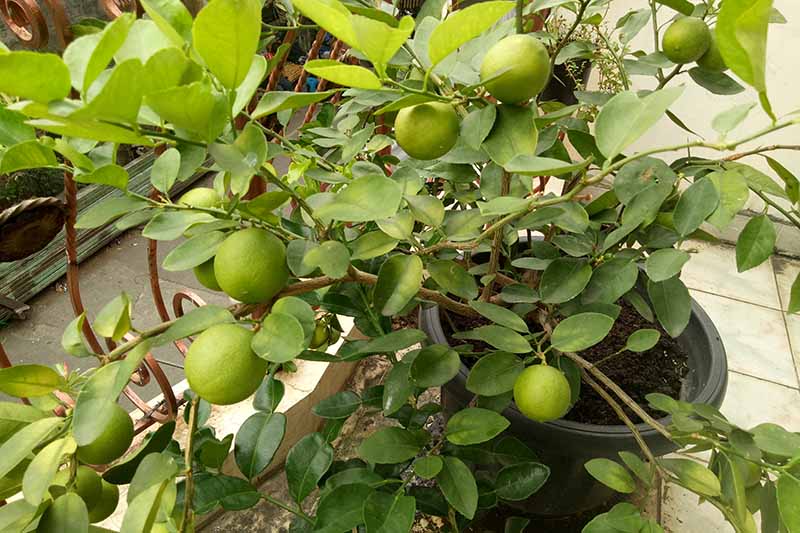
If you have space for more than one, why not grow several different types that produce fruit at various times of year?
Remember to be patient. It usually takes at least a few years for trees to bear fruit, depending on the variety and their age at the time when you plant them.
During the first few years of fruiting, harvests will tend to be small and inconsistent. At this point, trees are focusing their energy on developing strong roots and branches, creating a healthy foundation that will lead to larger harvests later on.
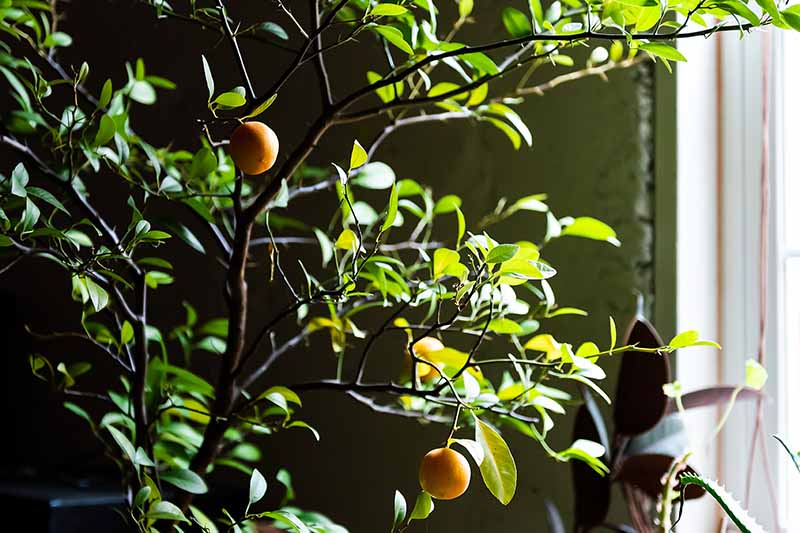
When the time does come to harvest, all you have to do is pick fruits when they are ripe. Taste testing is the best way to gauge ripeness, as the rind color doesn’t always indicate how ripe a fruit is. You can harvest over several months as fruits continue to ripen.
Bring the Tropics to You
While it may take a little extra love and care, growing citrus indoors can be seriously rewarding. I mean, what could be better than rolling out of bed and stumbling into your living room to pick a fresh lemon for your morning tea?
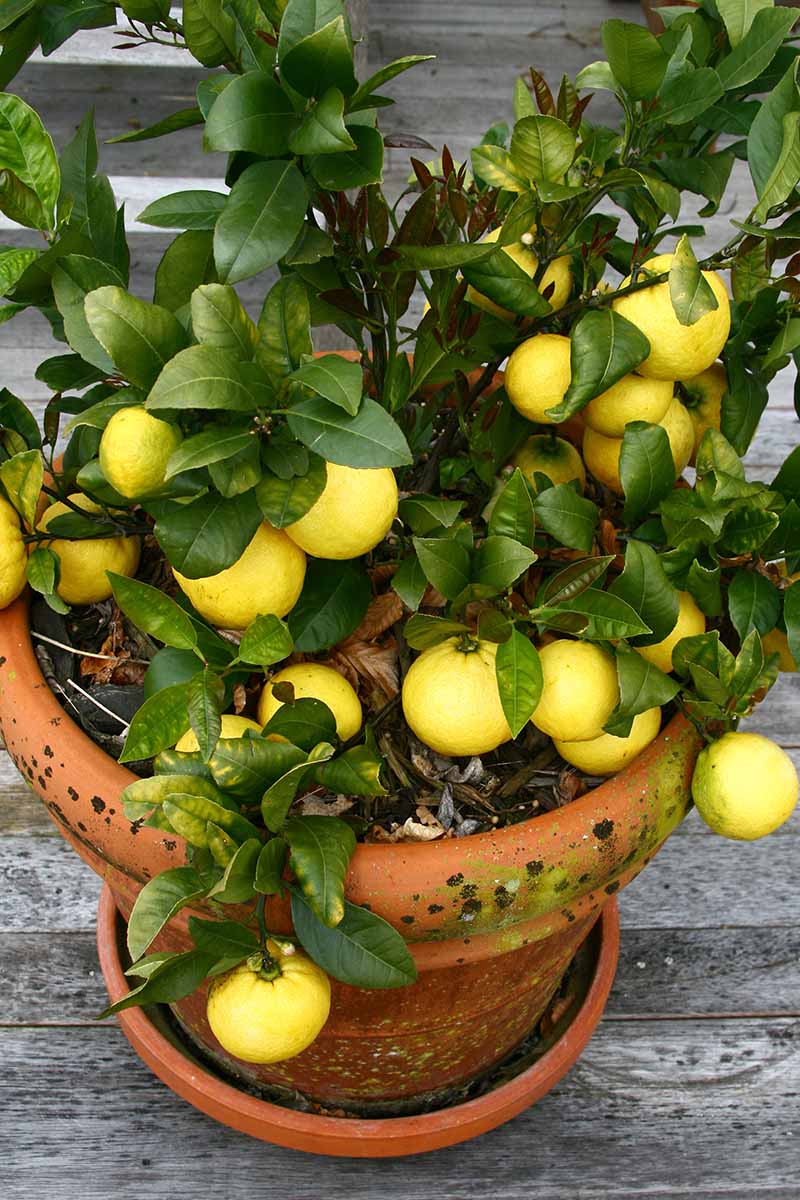
It may be cold and snowy outside, but inside is a little slice of paradise!
Have you had success growing citrus trees indoors? Share your advice and questions in the comments section below.
Interested in other fruit trees? Check out these growing guides next:

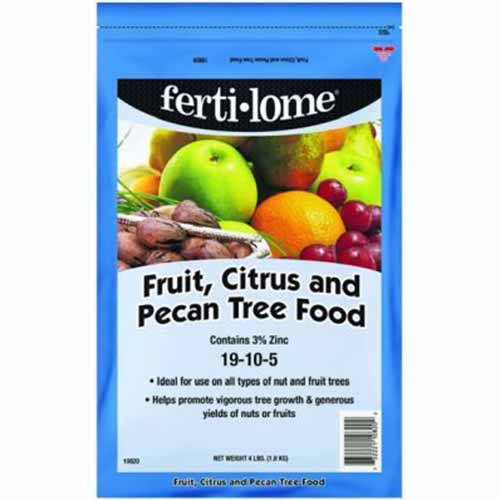


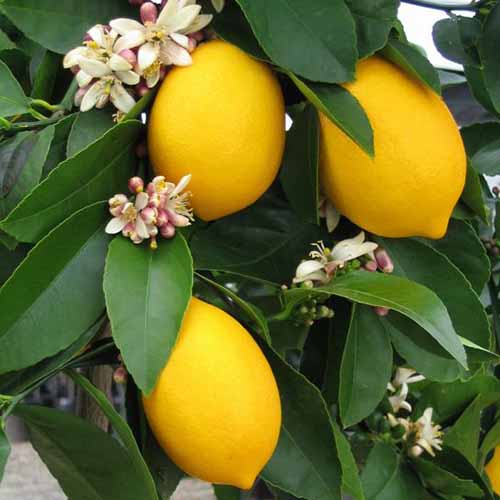
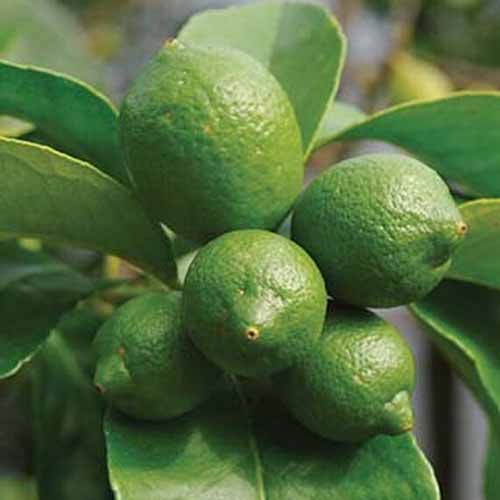
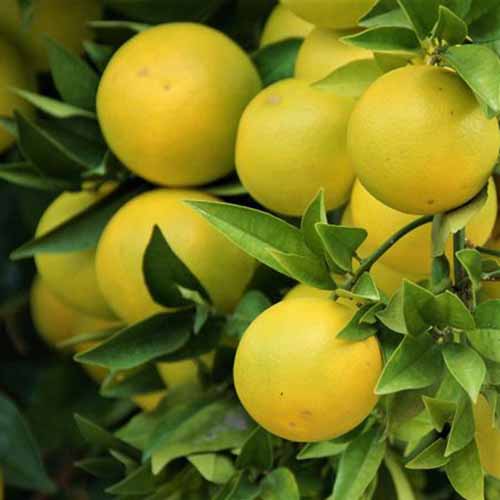
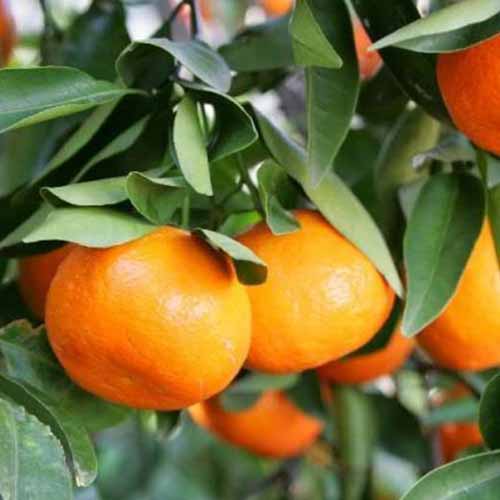
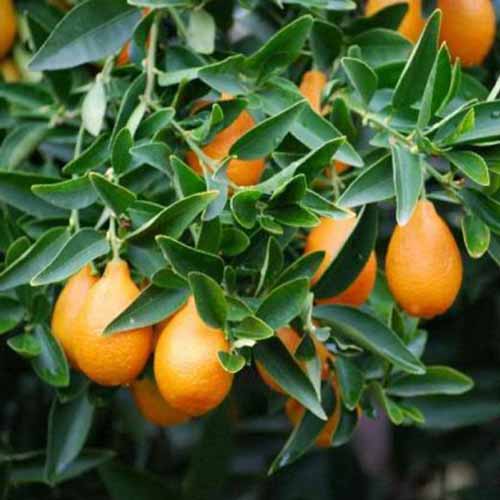
Thank you. It’s hard to find such helpful advice for growing my indoor citrus.
Thank you for your feedback. I am so glad you found this article useful. Good luck with your citrus plant!
Thanks a lot.
You’re welcome Shireen, thanks for reading Gardener’s Path!